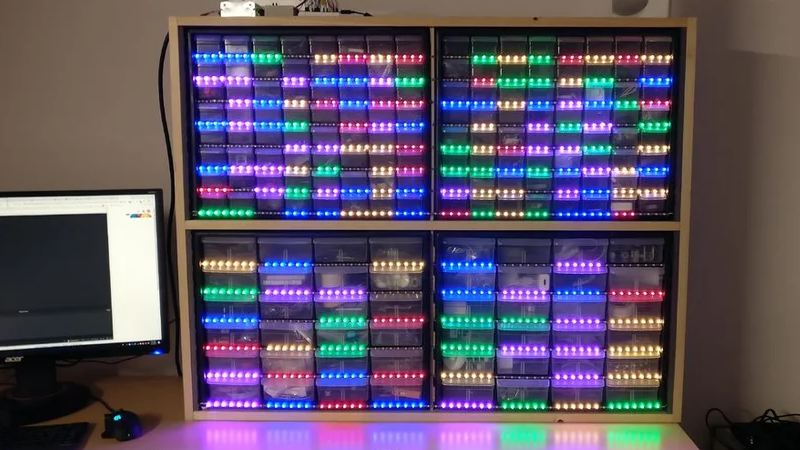It’s a problem every maker faces at one time or other – how to organise the ever-growing mass of components in the workshop. Some give up and just live with box upon box of disordered parts. That wasn’t good enough for [Inventor22], though – who created FindyBot3000 to tackle the job.
The first step is to source a set of those tiny component drawers we all know and love. These are then combined with WS2812B LED strips, which act as indicators for each individual drawer. A Particle Photon is used as the brains of the operation, and drives the strips. So far, so good.
Of course, blinking LEDs are great and all, but it’s the voice control where things get really interesting. Through Google Home and IFTTT, it’s possible to give commands to the Particle Photon. This can be used to manage the parts in the drawers, as well as to quickly highlight the location of various components. It’s backed up with an Azure backend, which manages the component database and keeps track of everything.
It’s a tidy build that does away with tiny sticky labels, and is reconfigurable on the fly as parts come and go. Of course, if you’re mostly storing SMD parts, you might prefer a reel based solution. Video after the break.
















Component drawers that /you/ may love.. I’ve gotten rid of all of mine and I’m happier for it.
Take away containers for big and fishing style boxes for small.
That being said, it’s a very interesting and clever build that if it can be decoupled from the cloud and a voice system would be useful for many.
I have done the opposite. I used to have multiple closed boxes and switched to keeping multiple things in drawers. Much better for access. (Unless you have cats/kids around who can take them down).
I’ve gone back and forth, from shelves to sectioned boxes to drawers full of bagged components. They’re all compromises. My latest attempt at organization is small screw-top containers, for which I made a wall-hanging base: http://www.chris3d.com/pix/components.jpg It’s decidedly low-tec, but it’s cheap, takes up no desk space and, depending on who you ask (namely me), is actually decorative!
Love the voice activation of this setup though, if the caps on my containers weren’t opaque, an LED in each hole would probably illuminate it like the drawers… Definitely something I’ll consider if/when I outgrow my wall thing.
Slightly larger version. More mechanical. Still fun.
https://www.instructables.com/id/StorageBot-voice-controlled-robotic-parts-finder/
Thats pretty cool
Agreed. My first thought was more in the high-involved-time custom for yourself department, but with how cheap something like a pi zero and led’s are, might almost be commercialize-able, especially if you cut down to only a single row and column of LED’s on the outer frame that you can intersect for the proper bin yourself. Maybe throw in a web interface that basically gives you an updatable excel spreadsheet to fill with descriptions that will be searched for voice-matches. Self-contained, relatively small BOM.
For the ISS, there is a man on the ground dedicated to this task. Space time is expensive, it is not possible to loose or to look for a tool for too long, so every time an astronaut have used a tool, he must tell the guy where he left it and the man update a database.
So, something above the cloud(s), uses a human to track “data”…
B^)
I am only using a simple Sheet to keep an inventory. It is quite faster that this, but of course this is hands free.
I thought about making a drawer indicator too…but in time I kind of learned where everything is and I have shifted drawers together which make sense to be located close by. But for a shared drawer set…clearly this is better.
Number the drawers. Enter description of what’s in the drawer in spreadsheet, add hyperlink to mechanical and/or data sheet. Done.
Search in the spreadsheet, find drawer number, click on data sheet.
Easy, scalable (I have 4 complete walls of parts…and growing).
Now, put a servo behind each drawer, to nudge the drawer out when you click on the spreadsheet cell.
B^)
i’m with you, Mac. keeping that spreadsheet up to date is the real valuable work, and findybot doesn’t really help with that.
This made me think of Makers, but that used RFID tagged everything with indicator lights IIRC. Looks great:)
I had an idea like this back when I worked at Walmart. You could have an app or kiosk. Search what you’re looking for and then just follow the lights to your item. It’d be easy to do since we always had the layout of the shelves.
Cool idea.
So, that’s your parts collection and now you got it neatly archived. Cool project!
I’m more of a hoarder, apparently….
Sweet fancy moses